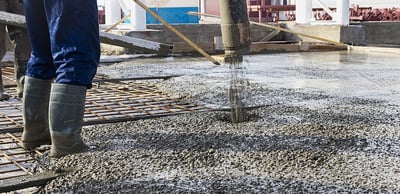
Not all contractors work in a climate where it’s warm enough all year round to pour concrete without special considerations. There are myths that say you shouldn’t work with concrete in the cold—but the truth is, you can still get the job done. You’ll just need to take some extra measures to make sure the concrete doesn’t end up brittle or cracked.
We’ll show you a few tips to work with concrete in cold weather, and we’ll also show you one of our favorite tools for concrete and masonry work, which is the ET&F® (a BECK member) Aerico® 90 tool and fastener system.
The Problem with Concrete in the Cold
Before we get to the tips, let’s first explain what cold weather does to concrete. There are two major issues to think about.
First is if the concrete should freeze. As concrete cures, it forms a matrix, and that’s what gives it its strength. If it freezes, that matrix breaks apart, which results in brittle concrete that is more prone to cracking.
The other problem is that concrete sets slower in the cold. The ideal temperature for setting concrete is around 70 degrees—slow enough so that the concrete doesn’t set too quickly (and become brittle), but not so slow that you’ll be waiting for ages for it to set. Around 50 degrees, the setting time for concrete doubles, which can cause job delays or damage if you inadvertently step on it or drop something on it. At 40 degrees, the reaction that creates the matrix that gives concrete strength stops, which will leave it brittle when it finally does set. And at 20 degrees, not only will it freeze, but it simply won’t set at all.
Working Around the Cold
Given the problems outlined above, the best thing you can do when temperatures dip is avoid pouring concrete at all. Keep an eye on the weather forecast, prep your grade, base, and forms, and wait for the start of a 7-day stretch of warm temperatures to pour.
The way many jobs go, however, you may not always have the luxury of waiting for better weather to pour. In that case, rely on some of the tips below to make the job go smoothly:
- Start with the right concrete mix. There are lots of brands and formulations to choose from, including those that perform better in cold weather—usually formulations with higher cement content.
- Add an accelerator like calcium chloride to your concrete mix to speed the setting time.
- Mix concrete using hot water, which will help keep it warmer longer as it sets up.
- Use less water, which will shorten the setting time and the amount of water that bleeds to the surface. Just be careful that you don’t use so little that the chemical reactions needed to cure concrete don’t take place.
- Use curing blankets, tarps, plastic sheeting covered in straw, or foam board insulation to cover the concrete and help keep it warmer.
Those tips should be enough to pour concrete when it’s chilly out so long as you avoid pouring on frozen ground or in the extreme cold.
The Right Tool for Working with Concrete
Once you’ve successfully poured concrete, you’ll want to start building on it—and you’re going to need a great fastener system to help you get the job done. That’s why we’ve created the Aerico® 90 tool, which drives ASM-144 pins and AKN-144 pins.
If you’ve worked with concrete before, then you know that concrete anchors and other types of fasteners can be a time-consuming chore. This is a pneumatic system that makes driving fasteners into concrete easy—just as easy as using a regular nail gun with lumber.
Fasteners for this tool are available taped or plastic collated, which makes it easy to load them into the driver. With the Aerico® 90, you’ll save time on the job, and the work will be much easier. Click below to learn more about this tool and fastener system.
.svg.png)

